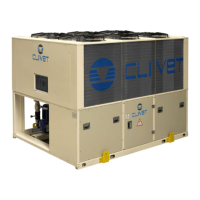
Do you have a question about the CLIVET WSAT-SC 80D Series and is the answer not in the manual?
Outlines critical safety instructions, handling, and unit usage guidelines.
Details components like compressors, heat exchangers, fans, and electrical panels.
Safety procedures for handling the unit to prevent falls or toppling.
Risks associated with incorrect installation and site selection.
Details risks of electric shock, fire, and electrocution due to improper electrical connections.
Warns about injury risks from moving fan rotors and safety procedures.
Risks from refrigerant gas escaping or contact with heat sources.
Detailed safety information for R-407C refrigerant, including first aid and handling.
Specifies protective measures and exposure limits for safe handling.
Covers cooling capacity, compressor details, heat exchangers, fans, connections, dimensions, weights, and operating limits.
Electrical specifications specific to the EN acoustic configuration.
Procedures for checking unit condition and reporting transit damage within 8 days.
Guidelines for safe handling operations, respecting safety norms and unit weight.
Recommendations and restrictions for unit placement.
Important considerations for piping design and hydraulic connections.
Measures to prevent freezing in water circuits, including glycol and heating cables.
Details on the modular pumping system, its benefits, and versions.
Requirements for qualified personnel, conformity with regulations, and electrical diagrams.
Tables showing full load current, locked rotor amperes, and power input for different configurations.
Step-by-step instructions for connecting the unit's power supply.
Essential checks before starting the unit, including installation and power supply.
Checking for oil stains, circuit pressure, and service outlet caps.
Ensuring proper screw tightening, grounding, panel security, and voltage checks.
Checking fluid temperatures, power supply, and unit/load absorptions.
How to ensure correct rotation direction and prevent damage.
Recording operational data like temperatures and pressures for maintenance.
Explains the main display, buttons, and menu access for unit control.
Procedures for identifying, resetting, and understanding alarms and faults.
Importance of maintenance for efficiency, breakdown prevention, and data logging.
Recommended frequency and scope of inspections by authorized centers.
Tables for testing refrigerant circuit operation using pressure and temperature parameters.
Detailed refrigerant pressure and temperature data for R22, R134a, R407C, R410A.
Continuation of detailed refrigerant pressure and temperature data.
Steps to identify and resolve issues with faulty probes.
Steps to identify and resolve issues with faulty pressure transducers.
Potential causes and checks for high pressure alarms.
Potential causes and checks for low pressure alarms.
Checks for compressor protection alarms, including wiring, voltage, and temperature.
Checks for fan protection alarms, including blocking, wiring, and voltage.
Checks for pump protection alarms, including blocking, wiring, and voltage.












